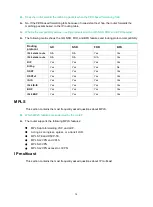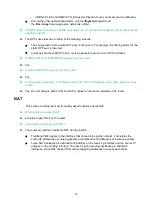
6
•
Flow control
—None
•
Parity
—None
•
Stop
bits
—1
•
Data
bits
—8
•
Terminal display type
—VT100
If you are running the terminal software SecureCRT, you must deselect the DTR/DSR option and
RTS/CTS option for flow control. By default, the RTS/CTS option is selected for flow control.
Q.
Data loss occurred after I logged in to the router through the console port. What should I do?
A.
Perform the following tasks:
1.
Enter console user interface view.
2.
Use the
speed
command to change the data rate to 115200 bps.
3.
Close the connection.
4.
Initiate a new console connection.
Q.
How can I clear a Telnet connection?
A.
Use the
free user-interface vty number
command in user view.
Q.
Can a Telnet user's username contain the at sign (@)?
A.
The username of a Telnet user that is configured on the router cannot contain the at sign (@).
Q.
I cleared the packet statistics on an interface by using the reset counters interface command. Why
does the MIB browser show that the error packet count is still the same?
A.
The MIB browser shows the values of the hardware counters. The
reset counters interface
command does not reset the hardware counters. This command clears only the statistics calculated
by software.
Q.
How do I format the Flash or CF card from the BootWare?
A.
To format the Flash or CF card:
1.
Access the extended BootWare menu.
2.
Access the storage media management menu and select the storage medium to be formatted.
3.
Format the storage medium.
For example, to format the Flash on an RSE-X3 MPU:
1.
Power on or reboot the router.
The startup information appears. (Details not shown.)
2.
Press
Ctrl + B
as prompted to enter the extended BootWare menu.
==========================<EXTENDED-BOOTWARE MENU>==========================
|<1> Boot System |
|<2> Enter Serial SubMenu |
|<3> Enter Ethernet SubMenu |
|<4> File Control |
|<5> Restore to Factory Default Configuration |
|<6> Skip Current System Configuration |
|<7> BootWare Operation Menu |






















